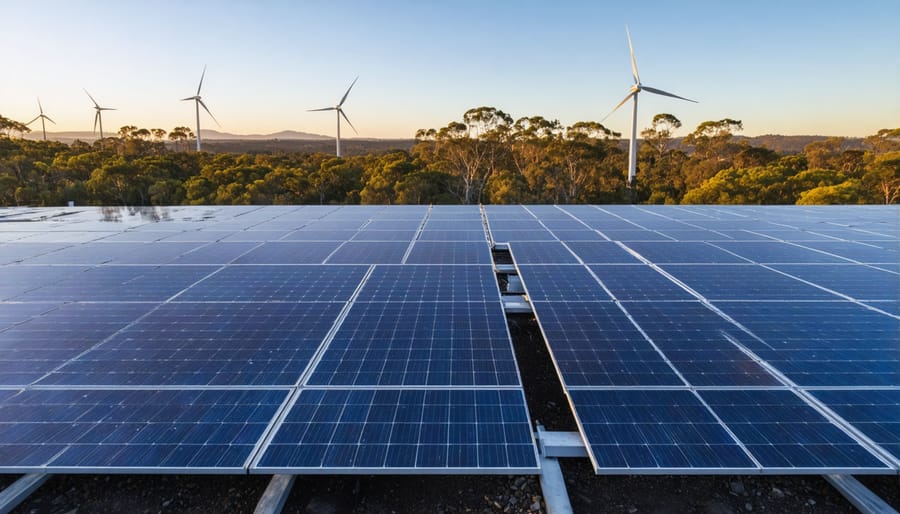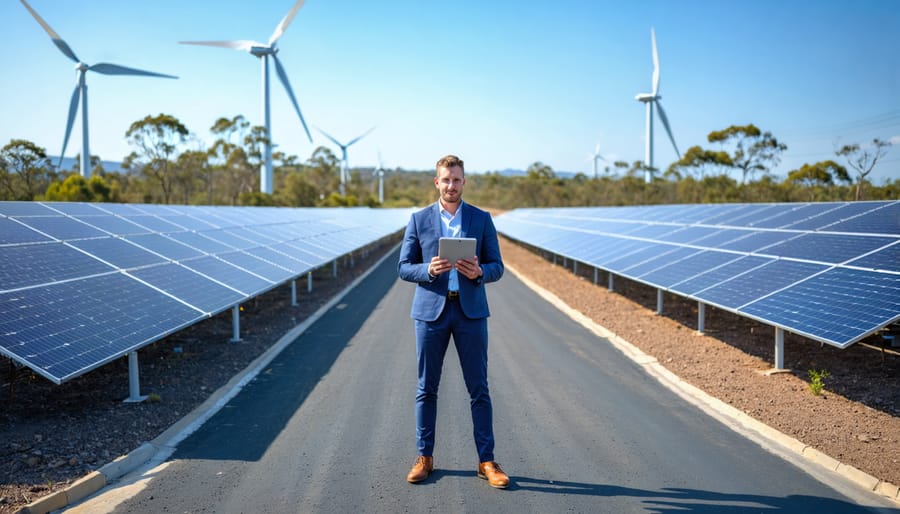Maximize your renewable energy returns by claiming the Investment Tax Credit (ITC), which can slash up to 30% off eligible solar, wind, and battery storage project costs. Australian investors are discovering that Infrastructure Investment Trusts (InvITs) focused on clean energy offer a powerful combination: stable quarterly income streams, tax-efficient structures, and meaningful environmental impact. These investment vehicles pool capital to fund large-scale renewable projects while passing through tax benefits directly to unitholders—essentially letting everyday investors access the same incentives previously reserved for major corporations.
Structure your portfolio to capture both immediate tax relief and long-term capital appreciation by investing in InvITs that own operational renewable assets. Unlike traditional shares, these trusts distribute 90% of their income to investors, creating predictable cash flow while reducing your taxable investment income. The renewable energy ITC applies when the InvIT acquires qualifying assets, with credits flowing proportionally to unitholders based on their stake.
Consider the practical impact: a $50,000 investment in a solar-focused InvIT could generate $1,500-$2,000 in annual distributions while potentially qualifying for significant tax credits during asset acquisition phases. Melbourne-based investor Sarah Chen reduced her effective tax rate by 12% last year while supporting three utility-scale solar farms through strategic InvIT positioning. This isn’t just smart money—it’s purposeful capital that accelerates Australia’s clean energy transition while building your financial security. The convergence of generous tax incentives, mature renewable technology, and accessible investment structures has created an unprecedented opportunity for values-aligned wealth building.
What Are Renewable Energy InvITs and Why They Matter

The Structure Behind InvITs
Infrastructure Investment Trusts, or InvITs, work like a community pool where multiple investors chip in to fund renewable energy projects that would be too large for individuals to tackle alone. Think of it as neighbours combining resources to install a massive solar farm, rather than just rooftop panels on one house.
Here’s how the structure works in practice: InvITs collect capital from various investors—from everyday Australians to large institutions—and channel these funds into established renewable energy infrastructure like wind farms, solar installations, or biomass facilities. These projects generate steady income through long-term power purchase agreements, which then flows back to investors as regular distributions, often with attractive tax benefits attached.
Similar to impact investment funds, InvITs democratise access to renewable energy investments that were once reserved for institutional players. The beauty of this structure is transparency—investors know exactly which projects their money supports, whether it’s a Queensland solar array or a Victorian biomass plant. This pooled approach spreads risk across multiple projects while amplifying collective environmental impact, proving that substantial change happens when we invest together toward a cleaner future.
Why Australia Needs More Renewable Energy Investment
Australia has set ambitious targets to achieve net zero emissions by 2050, with interim goals requiring a massive scale-up of renewable energy infrastructure. Currently, we’re facing a significant funding gap—estimated at over $70 billion—to meet these objectives and transition away from fossil fuels. This is where innovative investment structures become crucial.
Traditional government funding alone can’t bridge this gap. We need private capital flowing into renewable energy projects, and Investment Trusts (InvITs) combined with tax credits are helping make this happen. These mechanisms transform renewable energy from a purely environmental initiative into an attractive, financially viable opportunity for everyday Australians.
Bioenergy represents a particularly promising frontier. Unlike solar and wind, bioenergy can provide consistent baseload power while converting agricultural waste and organic materials into clean energy. Success stories are already emerging across regional Australia, where farmers are turning crop residues into renewable power while creating local jobs. With the right tax incentives, InvITs can channel investment toward these practical bioenergy solutions, helping communities prosper while protecting our environment for future generations.
Investment Tax Credits: Your Financial Advantage Explained
How Tax Credits Reduce Your Investment Risk
Let’s look at how tax credits transform renewable energy from a risky punt into a savvy investment—with real numbers that’ll make your calculator smile.
Imagine you’re investing $100,000 in a solar farm project through an InvIT. Without tax credits, you’re shouldering the full cost and hoping for decent returns over time. But here’s where it gets interesting: with a typical 30% investment tax credit, you immediately reduce your effective investment to $70,000. You’ve just lowered your financial exposure by $30,000 before the project even generates its first kilowatt!
For small investors, this shift is game-changing. Consider Sarah, a Brisbane teacher who invested $20,000 in a wind farm InvIT. The tax credit cut her actual outlay to $14,000, while her returns were calculated on the full $20,000 investment. This boosted her effective return from a projected 8% to approximately 11.4%—that’s nearly 43% higher returns on her actual money invested.
The mathematics get even better when you factor in ongoing revenue. That solar farm generating $8,000 annually now delivers an 11.4% return on your $70,000 actual investment, rather than 8% on $100,000. You’ve essentially created a financial cushion that protects against market fluctuations, equipment delays, or slower-than-expected adoption rates. The tax credit acts as your safety net, ensuring profitability even in challenging scenarios.

Eligibility Requirements You Need to Know
Understanding who can benefit from renewable energy investment tax credits is crucial for making informed decisions about sustainable investing. In Australia, these incentives are designed to be accessible to a broad range of participants, from individual investors to large institutions.
Eligible investors typically include Australian residents who invest in qualifying renewable energy Infrastructure Investment Trusts (InvITs) or directly in approved clean energy projects. You don’t need to be a large-scale investor to participate—many schemes welcome retail investors with modest capital, making sustainable investing achievable for everyday Australians who want to align their finances with their environmental values.
The types of renewable energy projects covered are comprehensive and exciting. Solar farms capturing our abundant sunshine, wind energy installations harnessing coastal breezes, biomass facilities converting organic waste into power, and hydroelectric projects are all typically eligible. Battery storage systems that stabilize renewable energy supply also qualify in many cases, reflecting the evolving nature of clean energy infrastructure.
For InvITs specifically, the investment vehicle must hold at least 80% of its assets in revenue-generating renewable energy infrastructure. Individual investors benefit from tax credits proportional to their stake, creating an attractive proposition where your environmental impact and financial returns grow together.
It’s worth noting that eligibility criteria can vary depending on the specific program and jurisdiction. Success stories from suburban families investing in community solar projects demonstrate how accessible these opportunities have become, proving that contributing to Australia’s renewable energy future whilst building your financial portfolio is within reach for committed investors at any level.
Success Stories: Australian InvITs Making Real Impact
Bioenergy Projects Leading the Charge
Several pioneering bioenergy projects across Australia have transformed the renewable energy landscape by leveraging investment tax credits, proving that smart financial incentives can drive remarkable environmental and community outcomes.
The Kwinana Waste-to-Energy facility in Western Australia stands as a stellar example. By utilizing renewable energy tax credits, this project converted what would have been 400,000 tonnes of household waste annually into clean electricity—enough to power 50,000 homes. The tax incentives made the initial infrastructure investment viable, allowing the facility to divert waste from landfills while generating renewable power. Local communities benefit from reduced landfill burden and cleaner air, whilst creating 80 permanent jobs in the region.
In regional Victoria, the Goulburn Valley biomass plant has become a game-changer for local farmers and the environment alike. Tax credits enabled the facility to process agricultural waste—everything from orchard prunings to rice husks—into renewable energy. This innovation has given farmers a profitable use for waste products whilst reducing the fire risk from crop residue burning. The project now powers 45,000 homes and has slashed carbon emissions by 350,000 tonnes annually.
Similarly, Queensland’s sugar industry has embraced bagasse cogeneration facilities, where tax incentives helped mills transform sugarcane waste into electricity. These projects demonstrate how bioenergy investments create circular economies, turning yesterday’s waste into today’s clean power whilst strengthening regional employment and agricultural sustainability.

Returns That Prove the Model Works
The numbers tell a compelling story. Australia’s Clean Energy Finance Corporation reports that renewable energy infrastructure investments have delivered average annual returns of 8-12% over the past five years, while simultaneously displacing over 2 million tonnes of carbon emissions annually. Take the Bomen Solar Farm InvIT, which has consistently paid quarterly distributions of 6.5% to investors since 2019, all while powering 28,000 NSW homes with clean energy.
These aren’t just feel-good numbers—they’re real returns hitting investor accounts. The Murra Warra Wind Farm InvIT in Victoria has outperformed initial projections, delivering 9.8% returns while creating 200 local jobs during construction. What makes these figures particularly attractive is their stability; renewable energy InvITs benefit from long-term power purchase agreements, providing predictable income streams that weather market volatility.
Beyond traditional InvITs, innovative approaches like crowdfunding renewable energy projects are democratising access to these returns, allowing everyday Aussies to invest smaller amounts while claiming proportional tax benefits. The dual benefit—competitive financial returns paired with measurable environmental impact—proves that profit and planet can work in perfect harmony.
How to Get Started With Renewable Energy InvIT Investment
Finding the Right InvIT for Your Goals
Choosing the right InvIT requires careful consideration of your financial goals and environmental values. Start by examining the InvIT’s portfolio composition—those heavily invested in solar, wind, and bioenergy projects typically offer stronger sustainability credentials alongside competitive returns.
Look for InvITs with transparent reporting on their environmental impact. The best opportunities clearly demonstrate how they’re reducing carbon emissions and supporting Australia’s renewable energy targets. Pay particular attention to bioenergy projects, which not only generate clean power but also address waste management challenges in agricultural communities.
Consider the InvIT’s track record and management expertise. Have they successfully delivered projects on time? Do they have partnerships with established renewable energy operators? InvITs focused on operational assets generally provide more stable income streams than those investing in greenfield developments.
Don’t overlook diversification within your renewable portfolio. While exploring InvIT opportunities, consider how they complement other green finance options you might be investigating.
Finally, align your choice with your values. If supporting regional Australian communities matters to you, prioritize InvITs investing in rural bioenergy facilities that create local jobs while generating clean energy from agricultural residues and native grasses.
Working With Tax Professionals to Maximize Benefits
Navigating renewable energy tax credits can feel like traversing unfamiliar territory, but you don’t have to go it alone. Working with qualified tax professionals who understand renewable energy investments ensures you’re capturing every dollar of available incentives while staying compliant with Australian Tax Office requirements.
A good tax advisor familiar with renewable energy schemes can identify credits you might otherwise miss—from solar installation deductions to depreciation benefits on InvIT holdings. They’ll help structure your investments tax-efficiently, timing your purchases and claims strategically throughout the financial year.
When choosing a professional, look for someone with proven experience in renewable energy taxation and a track record of working with environmentally focused investments. Ask about their familiarity with Infrastructure Investment Trusts and recent changes to clean energy incentives.
Consider this a partnership rather than just a service. Share your sustainability goals alongside your financial objectives—many advisors are passionate about supporting Australia’s clean energy transition and will champion investments that align your values with solid returns. The modest investment in professional guidance typically pays for itself several times over through optimized claims and avoided mistakes, while giving you confidence that you’re maximizing both your financial benefits and environmental impact.
The Broader Impact: Jobs, Energy Security, and Climate Action
When you choose to invest in renewable energy through tax-advantaged structures, you’re doing far more than securing your financial future—you’re actively participating in Australia’s clean energy transformation.
Every dollar directed toward renewable energy infrastructure creates tangible employment opportunities across the country. The solar, wind, and bioenergy sectors are among Australia’s fastest-growing job markets, employing installers, engineers, maintenance technicians, project managers, and manufacturing specialists. Your investment helps fund community energy projects that generate local employment while building regional resilience. These aren’t temporary positions either—they’re long-term careers that support families and strengthen communities right here at home.
Beyond employment, renewable energy investment directly enhances Australia’s energy security. By funding domestic solar farms, wind installations, and bioenergy facilities, you’re reducing our reliance on imported fossil fuels and volatile international energy markets. When extreme weather events or global disruptions threaten traditional energy supplies, locally-generated renewable power keeps Australian homes and businesses running. This energy independence isn’t just practical—it’s essential for our national security and economic stability.
The climate impact of these collective investment decisions cannot be overstated. Australia’s renewable energy sector has already prevented millions of tonnes of carbon emissions from entering our atmosphere. Each megawatt of clean energy capacity displaces fossil fuel generation, directly contributing to our national emissions reduction targets. When you invest through tax-advantaged renewable energy structures, you’re helping Australia meet its Paris Agreement commitments while protecting our unique ecosystems—from the Great Barrier Reef to our ancient bushland.
The beauty of renewable energy investment tax credits is this multiplier effect: your financial decision triggers job creation, strengthens energy independence, and delivers measurable climate action. It’s proof that smart investing and environmental stewardship aren’t competing priorities—they’re complementary forces driving Australia toward a cleaner, more prosperous future.
The beauty of renewable energy InvITs lies in their remarkable ability to deliver a win-win outcome—strengthening your financial position while contributing to a healthier planet for future generations. When you combine the attractive returns from renewable energy infrastructure with tax credits that boost your bottom line, you’re not just making a smart investment decision; you’re becoming part of Australia’s clean energy transformation story.
Every dollar invested in renewable energy InvITs supported by tax credits does double duty. It works hard in your portfolio, generating stable income streams and potential capital growth, while simultaneously displacing fossil fuel generation and reducing carbon emissions. These aren’t abstract benefits—they translate into cleaner air for our communities, reduced climate impacts, and new job opportunities across regional Australia.
The financial advantages are clear and compelling: tax credits lower your effective investment cost, regular distributions provide reliable income, and the underlying assets—solar farms, wind facilities, and battery storage systems—represent the future of energy generation. Meanwhile, the environmental ledger shows measurable progress: tonnes of carbon avoided, renewable capacity added to the grid, and momentum building toward Australia’s net-zero targets.
Now is the time to act. The combination of supportive policy settings, proven technology, and growing market demand creates an ideal environment for renewable energy investment. By choosing InvITs that qualify for tax credits, you’re positioning yourself at the intersection of profit and purpose—an opportunity that benefits both your wallet and the world we all share.

